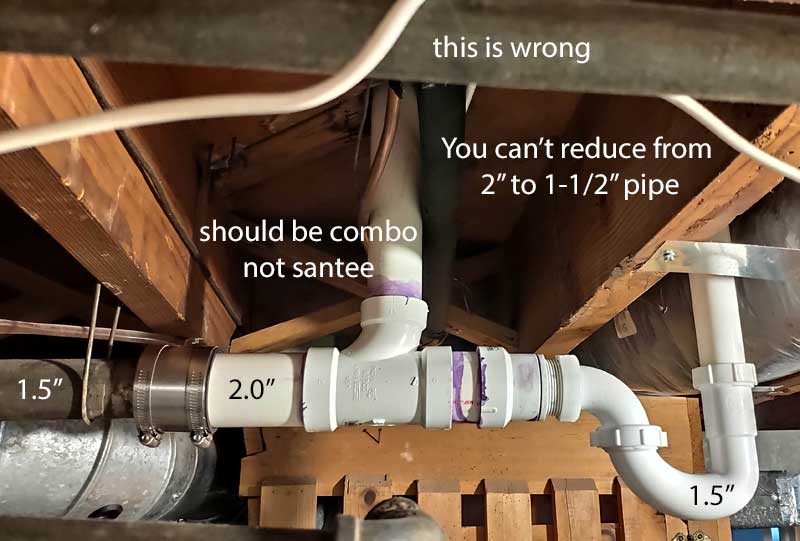If you're in the process of renovating your bathroom or simply looking to update your sink's plumbing, it's important to understand the different types of bathroom sink drain pipes available. From materials to sizes to common issues, this guide will cover everything you need to know about bathroom sink drain pipes.Bathroom Sink Drain Pipes
Over time, bathroom sink drain pipes can become worn out or damaged, resulting in leaks or clogs. When this happens, it's important to replace the drain pipe to prevent further issues. The process involves removing the old pipe and installing a new one, which can be done by a professional plumber or as a DIY project.Bathroom Sink Drain Pipe Replacement
The size of your bathroom sink drain pipe is determined by the diameter of the pipe. Most bathroom sink drain pipes have a diameter of 1 ¼ inches, but some larger sinks may require a 1 ½ inch pipe. It's important to know the size of your drain pipe when replacing it to ensure a proper fit.Bathroom Sink Drain Pipe Size
One of the most common issues with bathroom sink drain pipes is leaking. This can be caused by a variety of factors, such as a loose connection, corroded pipes, or worn out seals. If you notice water pooling under your sink or a foul smell coming from the pipes, it's important to address the issue quickly to prevent further damage.Bathroom Sink Drain Pipe Leaking
Clogged bathroom sink drain pipes are another common issue that can be caused by a buildup of hair, soap scum, or other debris. In some cases, a plunger or drain snake can be used to clear the clog, but for more stubborn clogs, a professional plumber may be needed. Regularly cleaning your drain pipes can help prevent clogs from occurring.Bathroom Sink Drain Pipe Clogged
Installing a new bathroom sink drain pipe may seem like a daunting task, but with the right tools and knowledge, it can be done as a DIY project. However, if you're not confident in your plumbing skills, it's always best to hire a professional to ensure the job is done correctly and to prevent any potential issues in the future.Bathroom Sink Drain Pipe Installation
A bathroom sink drain pipe is made up of several parts, including the tailpiece, trap, and drain flange. The tailpiece connects the sink to the trap, which is a curved pipe that prevents sewer gases from entering your bathroom. The drain flange is the visible part of the drain that sits at the bottom of the sink and connects to the tailpiece.Bathroom Sink Drain Pipe Parts
If your bathroom sink drain pipe is leaking or clogged, it's important to repair it as soon as possible to prevent further damage. Depending on the issue, the repair process may involve replacing a specific part of the drain pipe or the entire pipe itself. It's best to consult a professional plumber for any necessary repairs.Bathroom Sink Drain Pipe Repair
To better understand how a bathroom sink drain pipe works, it's helpful to refer to a diagram. A typical bathroom sink drain pipe diagram will show the different parts of the drain and how they connect to each other. You can find diagrams online or consult a professional plumber for a visual representation.Bathroom Sink Drain Pipe Diagram
Venting is an important aspect of bathroom sink drain pipe installation. Venting allows air to enter the drain pipe, which helps with the flow of water and prevents sewer gases from entering your bathroom. It's important to ensure proper venting when installing a new drain pipe to prevent any potential issues. In conclusion, understanding the different types, sizes, and common issues of bathroom sink drain pipes is crucial for any homeowner. Whether you're looking to replace your old drain pipe or troubleshoot a problem, it's always best to consult a professional plumber for any necessary repairs or installations.Bathroom Sink Drain Pipe Venting
How to Keep Your Bathroom Sink Drain Pipes Clear and Clean

The Importance of Maintaining Your Bathroom Sink Drain Pipes
 Bathroom sink drain pipes are an essential component of any house design. They are responsible for carrying out all the wastewater from your bathroom and keeping your sink and surrounding area clean. However, over time, these pipes can become clogged with hair, soap scum, and other debris, leading to slow drainage and unpleasant odors. Therefore, it is crucial to regularly maintain and clean your bathroom sink drain pipes to avoid any potential plumbing issues.
Bathroom sink drain pipes are an essential component of any house design. They are responsible for carrying out all the wastewater from your bathroom and keeping your sink and surrounding area clean. However, over time, these pipes can become clogged with hair, soap scum, and other debris, leading to slow drainage and unpleasant odors. Therefore, it is crucial to regularly maintain and clean your bathroom sink drain pipes to avoid any potential plumbing issues.
Tools and Supplies You Will Need
 To keep your bathroom sink drain pipes clear and clean, you will need a few simple tools and supplies. These include a plunger, a drain snake or auger, a pair of rubber gloves, baking soda, white vinegar, and hot water. These items are readily available in most households, making it easy for you to maintain your drain pipes without any extra expenses.
To keep your bathroom sink drain pipes clear and clean, you will need a few simple tools and supplies. These include a plunger, a drain snake or auger, a pair of rubber gloves, baking soda, white vinegar, and hot water. These items are readily available in most households, making it easy for you to maintain your drain pipes without any extra expenses.
Step-by-Step Guide to Cleaning Your Bathroom Sink Drain Pipes
 Step 1: Remove any visible debris
Start by removing any visible debris, such as hair and soap scum, from the drain opening using a pair of rubber gloves. This will prevent the debris from getting pushed further into the pipes during the cleaning process.
Step 2: Use a plunger
Next, use a plunger to create a suction and pressure that will dislodge any stubborn clogs in the pipes. Make sure to cover the entire drain opening with the plunger and push and pull vigorously for a few minutes to loosen the clog.
Step 3: Try a drain snake or auger
If the plunger does not work, you can use a drain snake or auger to break up and remove the clog. Insert the tool into the drain and rotate it while pushing it further in to break up the clog. Once the clog has been loosened, pull out the tool, and any debris should come out with it.
Step 4: Use a natural cleaning solution
To further clean and deodorize your drain pipes, you can use a natural cleaning solution made of baking soda and white vinegar. Pour half a cup of baking soda into the drain, followed by a cup of white vinegar. Let the mixture sit for 10-15 minutes, then pour hot water down the drain to flush out any remaining debris.
Step 1: Remove any visible debris
Start by removing any visible debris, such as hair and soap scum, from the drain opening using a pair of rubber gloves. This will prevent the debris from getting pushed further into the pipes during the cleaning process.
Step 2: Use a plunger
Next, use a plunger to create a suction and pressure that will dislodge any stubborn clogs in the pipes. Make sure to cover the entire drain opening with the plunger and push and pull vigorously for a few minutes to loosen the clog.
Step 3: Try a drain snake or auger
If the plunger does not work, you can use a drain snake or auger to break up and remove the clog. Insert the tool into the drain and rotate it while pushing it further in to break up the clog. Once the clog has been loosened, pull out the tool, and any debris should come out with it.
Step 4: Use a natural cleaning solution
To further clean and deodorize your drain pipes, you can use a natural cleaning solution made of baking soda and white vinegar. Pour half a cup of baking soda into the drain, followed by a cup of white vinegar. Let the mixture sit for 10-15 minutes, then pour hot water down the drain to flush out any remaining debris.
Preventative Maintenance Tips
 To prevent future clogs in your bathroom sink drain pipes, here are a few useful tips:
- Use a drain strainer to catch any hair and debris before they go down the drain.
- Avoid pouring grease, oils, and harsh chemicals down the drain.
- Regularly clean your drain pipes using the steps mentioned above to prevent buildup and maintain proper drainage.
To prevent future clogs in your bathroom sink drain pipes, here are a few useful tips:
- Use a drain strainer to catch any hair and debris before they go down the drain.
- Avoid pouring grease, oils, and harsh chemicals down the drain.
- Regularly clean your drain pipes using the steps mentioned above to prevent buildup and maintain proper drainage.
By regularly maintaining your bathroom sink drain pipes, you can avoid plumbing issues and keep your sink area clean and hygienic. With a few simple tools and supplies, you can easily keep your drain pipes clear and clean, ensuring a smooth and functional plumbing system in your home.
















































































